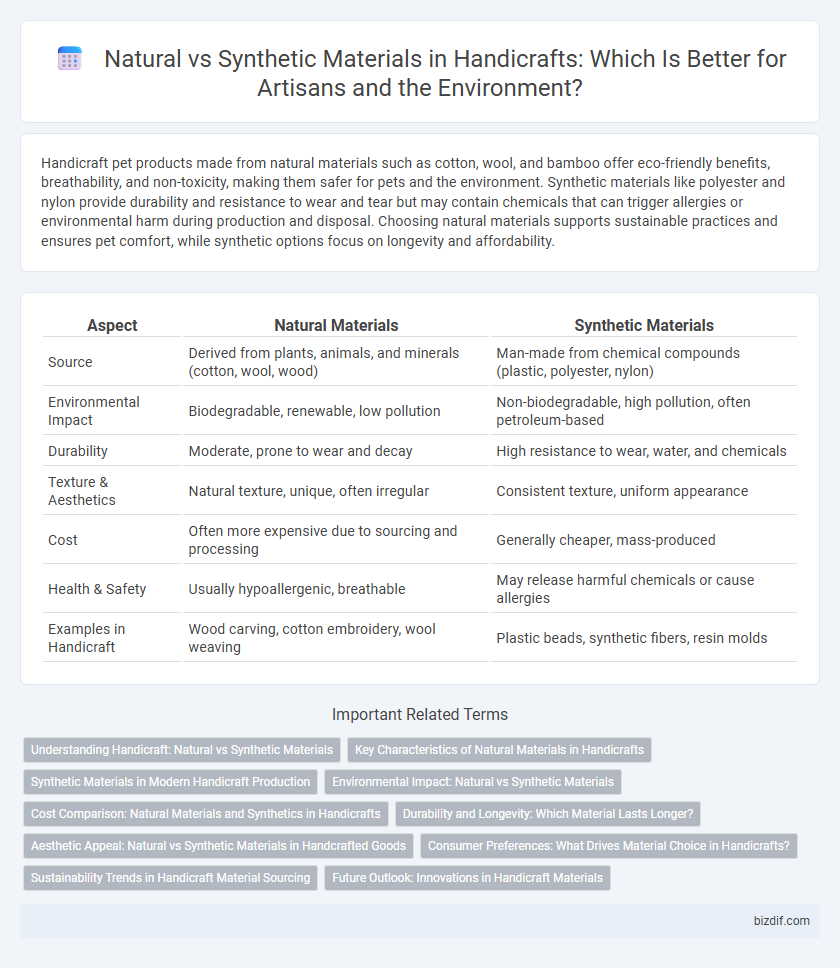Handicraft pet products made from natural materials such as cotton, wool, and bamboo offer eco-friendly benefits, breathability, and non-toxicity, making them safer for pets and the environment. Synthetic materials like polyester and nylon provide durability and resistance to wear and tear but may contain chemicals that can trigger allergies or environmental harm during production and disposal. Choosing natural materials supports sustainable practices and ensures pet comfort, while synthetic options focus on longevity and affordability.
Table of Comparison
| Aspect | Natural Materials | Synthetic Materials |
|---|---|---|
| Source | Derived from plants, animals, and minerals (cotton, wool, wood) | Man-made from chemical compounds (plastic, polyester, nylon) |
| Environmental Impact | Biodegradable, renewable, low pollution | Non-biodegradable, high pollution, often petroleum-based |
| Durability | Moderate, prone to wear and decay | High resistance to wear, water, and chemicals |
| Texture & Aesthetics | Natural texture, unique, often irregular | Consistent texture, uniform appearance |
| Cost | Often more expensive due to sourcing and processing | Generally cheaper, mass-produced |
| Health & Safety | Usually hypoallergenic, breathable | May release harmful chemicals or cause allergies |
| Examples in Handicraft | Wood carving, cotton embroidery, wool weaving | Plastic beads, synthetic fibers, resin molds |
Understanding Handicraft: Natural vs Synthetic Materials
Natural materials like wood, cotton, and wool offer unique textures and environmental sustainability essential in traditional handicraft, promoting biodegradability and minimal chemical processing. Synthetic materials such as acrylic, polyester, and nylon provide durability, vibrant colors, and affordability, enabling mass production and innovative design possibilities in contemporary crafts. Understanding the distinctions between natural and synthetic materials helps artisans choose the right medium based on environmental impact, aesthetic goals, and functional needs.
Key Characteristics of Natural Materials in Handicrafts
Natural materials in handicrafts, such as wood, cotton, wool, and clay, offer sustainability, breathability, and biodegradability, making them eco-friendly choices. These materials provide unique textures and organic patterns that enhance the aesthetic and tactile appeal of handcrafted items. Their renewable nature and minimal processing contribute to preserving traditional craftsmanship and supporting environmental conservation.
Synthetic Materials in Modern Handicraft Production
Synthetic materials, such as acrylic, polyester, and nylon, have revolutionized modern handicraft production by offering durability, flexibility, and vibrant color options not always available with natural materials. These man-made fibers enable artisans to create intricate designs with consistent quality and lower production costs, facilitating mass production while maintaining artistic expression. The integration of synthetic materials supports innovation in handicrafts, expanding creative possibilities and enhancing product longevity.
Environmental Impact: Natural vs Synthetic Materials
Natural materials such as cotton, wool, and bamboo have a lower environmental impact due to their biodegradability and renewable sources, reducing landfill waste and pollution. Synthetic materials like polyester and nylon, derived from petrochemicals, contribute significantly to microplastic pollution and rely heavily on non-renewable fossil fuels. Choosing natural materials supports sustainable handicraft practices by minimizing carbon footprints and promoting eco-friendly production cycles.
Cost Comparison: Natural Materials and Synthetics in Handicrafts
Natural materials in handicrafts, such as wood, cotton, and bamboo, typically have higher initial costs due to harvesting and processing but offer durability and eco-friendliness that can reduce long-term expenses. Synthetic materials like plastic and polyester often provide lower upfront prices and consistent quality, enabling mass production at scale with reduced labor costs. However, synthetic options may incur environmental costs and potential consumer preference shifts toward sustainable handicraft products.
Durability and Longevity: Which Material Lasts Longer?
Natural materials like wood, wool, and cotton offer biodegradability and a unique aesthetic but tend to degrade faster due to exposure to moisture, sunlight, and pests. Synthetic materials such as polyester, acrylic, and nylon are engineered for enhanced durability, resisting wear, fading, and environmental damage over time. Choosing synthetic materials generally ensures greater longevity in handicraft products, making them ideal for items requiring sustained use and minimal maintenance.
Aesthetic Appeal: Natural vs Synthetic Materials in Handcrafted Goods
Natural materials in handcrafted goods offer unique textures, organic patterns, and a warm, authentic aesthetic closely tied to cultural traditions, enhancing the visual and tactile appeal. Synthetic materials provide consistent colors, durability, and versatility, allowing artisans to experiment with innovative designs and vibrant finishes not easily achievable with natural elements. The choice between natural and synthetic materials significantly influences the overall aesthetic, blending heritage craftsmanship with modern artistic expression.
Consumer Preferences: What Drives Material Choice in Handicrafts?
Consumer preferences in handicrafts are strongly influenced by the sustainability and authenticity associated with natural materials such as wood, cotton, and jute, which appeal to eco-conscious buyers seeking originality and environmental responsibility. Synthetic materials like polyester and acrylic attract consumers prioritizing durability, cost-effectiveness, and vibrant color retention, often favored in mass-produced handicrafts. Market trends indicate a growing demand for hybrid products that combine the tactile appeal of natural fibers with the enhanced performance features of synthetics, reflecting a shift toward functional aesthetics in handmade goods.
Sustainability Trends in Handicraft Material Sourcing
Natural materials such as bamboo, jute, and organic cotton dominate sustainability trends in handicraft material sourcing due to their biodegradability and low environmental impact. Synthetic materials, often derived from petroleum, face growing criticism for their ecological footprint and challenges in compostability. Artisans and consumers increasingly prioritize eco-friendly, renewable resources to ensure sustainable growth in the handicraft industry.
Future Outlook: Innovations in Handicraft Materials
Innovations in handicraft materials are increasingly focusing on the sustainability and functionality of natural and synthetic options, with bio-based polymers and recycled fibers gaining prominence. Advanced treatments and hybrid composites enhance durability while maintaining the tactile and aesthetic qualities prized in natural materials like bamboo, hemp, and organic cotton. The future outlook highlights a shift towards eco-friendly, biodegradable synthetics combined with traditional craftsmanship to meet both environmental goals and consumer demand for authentic, innovative handicrafts.
Natural Materials vs Synthetic Materials Infographic

 bizdif.com
bizdif.com